Same Politics, Different Results: Why the LDS Enclave Outperforms Other Conservative Communities
Part 3 Of The LDS Enclave Deep Dive

TL;DR
The LDS Enclave shares many political and cultural traits with other conservative regions in the U.S. — it's religious, right-leaning, and family-oriented. But when it comes to actual outcomes, it consistently outperforms its conservative peers.
Compared to Evangelical Hubs and other red-leaning areas, the LDS Enclave has:
Higher education levels and lower poverty rates
More homeownership and greater financial preparedness
Stronger family structures and lower single parenthood
A younger, more future-oriented population
These successes may stem from a unique mix of tight-knit congregational infrastructure, cultural norms around preparedness and self-reliance, and strong institutional support from the LDS Church.
Still, the picture isn’t perfect — the region struggles with a high racial segregation score and a significant gender pay gap.
In short: same politics, better outcomes — but with important caveats.
Introduction
In many ways, the LDS enclave looks like other conservative communities across America. It’s politically right-leaning, deeply religious, and has strong family values. But when you look closer — at economic stability, family structure, housing security, and financial preparedness — the LDS enclave consistently comes out ahead of those communities.
How is that possible? How can a community that shares so many political and cultural traits with other conservative regions end up with better outcomes?
This is the third post in my deep dive into the LDS enclave, a term defined by the American Communities Project to describe high density Mormon counties in Utah and parts of Idaho. In earlier posts, I explored what issues matter most to this community and how its members think about trust, service, and belonging. Today, we turn to demographics and socioeconomics — the basic building blocks of life outcomes.
We’ll look at who lives in the LDS enclave, how they compare to other Americans, and why this region may be quietly succeeding in ways that few outside observers fully understand.
Charts
The LDS Enclave is one of the youngest communities in America — 28% of its population is under 18, behind only Native American Lands. It’s also relatively well-educated for a conservative region: 35% of residents hold a bachelor’s degree, nearly double the rate in Evangelical Hubs (17%).
Despite its geographic roots in the Mountain West, the LDS Enclave isn’t especially rural — just over half of its population lives in rural areas, compared to nearly 80% in Evangelical Hubs. This balance between urban access and rural values may be part of its strength.
The LDS Enclave is 85% non-Hispanic White — similar to other conservative regions — but it diverges in other ways. It has the lowest share of non-Hispanic Black residents (essentially zero), but stands out for higher representation of Native Americans, Hispanics, and Pacific Islanders, especially compared to Evangelical regions.
While still racially homogeneous, the Enclave reflects its Western geography and LDS missionary legacy more than national racial patterns.
The LDS Enclave has higher-than-the-average-community share of Native Americans (1.4%), Pacific Islanders (0.27%), and Hispanics (10%). While the numbers are small in absolute terms, they are notable compared to other communities.
The median household income in the LDS Enclave is just over $63,000 — close to the national average — but it punches above its weight. Homeownership is extremely high (77%) and a lower living wage is required to make ends meet compared to big cities or coastal regions.
This is a community where middle-income families can still access the American Dream. Though admittedly, similar to other parts of America, housing has become increasingly unaffordable in recent years.
Few communities rival the LDS Enclave in family outcomes. Just 13% of children live in single-parent households — the lowest of any other community. Child poverty (11%) and reliance on reduced-price lunch programs (35%) are also well below national and conservative-region averages.
In other words, the values that many conservative regions aspire to are actually being lived out here.
LDS Enclave residents are more likely to save for retirement (28% have a 401k) and invest in stocks and mutual funds. They also participate in digital consumer culture — 72% of households have an Amazon Prime subscription, placing them among the most digitally connected regions in the country.
This reflects not just stability, but a proactive mindset toward financial well-being.
While the LDS Enclave excels in many economic and family outcomes, it underperforms when it comes to equity.
Racial Segregation: The Enclave has the highest racial segregation score (70), indicating significant residential separation between Black and white residents. While the Black population is extremely small in these areas, the data suggests that where diversity exists, it often comes with separation.
Gender Pay Gap: Women in the LDS Enclave earn just 68 cents for every dollar men earn — the lowest ratio of any region in the American Communities Project. This gap is significantly worse than the national average (81 cents) and even trails other conservative regions like Evangelical Hubs (77 cents).
The same traditional structures that support family stability may also reinforce outdated gender norms and contribute to racial separation, even in relatively diverse areas. This is likely related to LDS enclave political priorities where economic progress and issues trump many modern social ones. Read more below:
So Why Does The LDS Enclave Have Better Outcomes Than Evangelical Hubs?
At first glance, the LDS Enclave shares many characteristics with other conservative communities in America — religious commitment, traditional family structures, and political leanings. But when we look at outcomes — family stability, financial preparedness, homeownership, poverty rates — the LDS Enclave consistently performs better.
Why?
While this post can’t offer a full causal explanation, there are a few likely contributors:
Congregational Infrastructure: The LDS Church’s ward system organizes members into tight-knit, geography-based communities where service, check-ins, and responsibility are routine. This structure fosters regular social interaction, informal safety nets, and collective norms around family and finance.
Religious Social Capital: Unlike more individualistic conservative communities, LDS culture strongly encourages volunteering, mutual aid, and tithing. That may translate into stronger trust and more stable households.
Self-Reliance + Preparedness Culture: Mormonism uniquely emphasizes long-term planning, education, emergency preparedness, and avoiding debt. That may explain the high rates of 401(k) ownership, stock investing, and low housing strain despite only middle-of-the-road incomes.
Strong Institutional Support: The Church’s welfare system, employment services, and social support structures may blunt the economic consequences of job loss or personal crisis in ways that don’t exist in many evangelical or rural conservative communities.
Of course, not everything is ideal — high racial segregation and gender pay gaps complicate the picture — but the LDS enclave offers a fascinating example of how shared values, when paired with strong institutions, can lead to more resilient outcomes.
Feel free to let me know what you think about my analysis here and see you next week where we talk about Latter-day Saint health outcomes & technology.



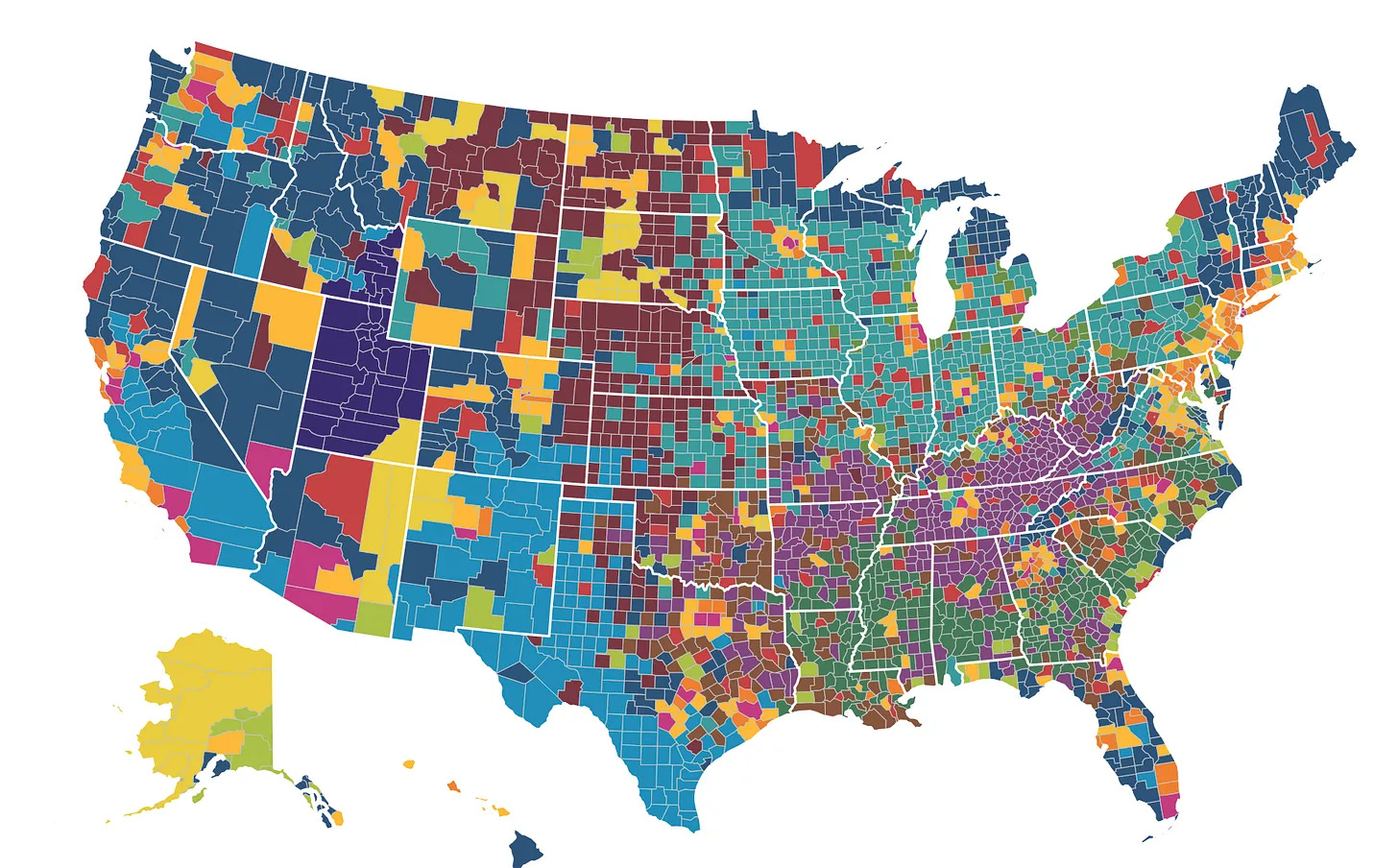
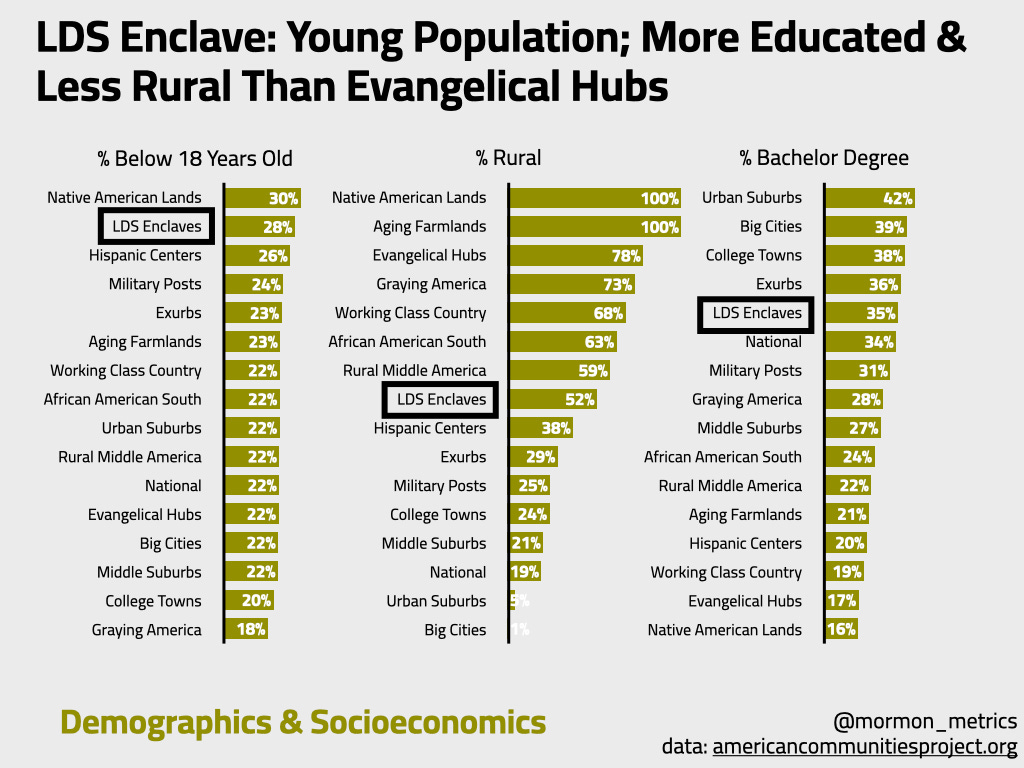
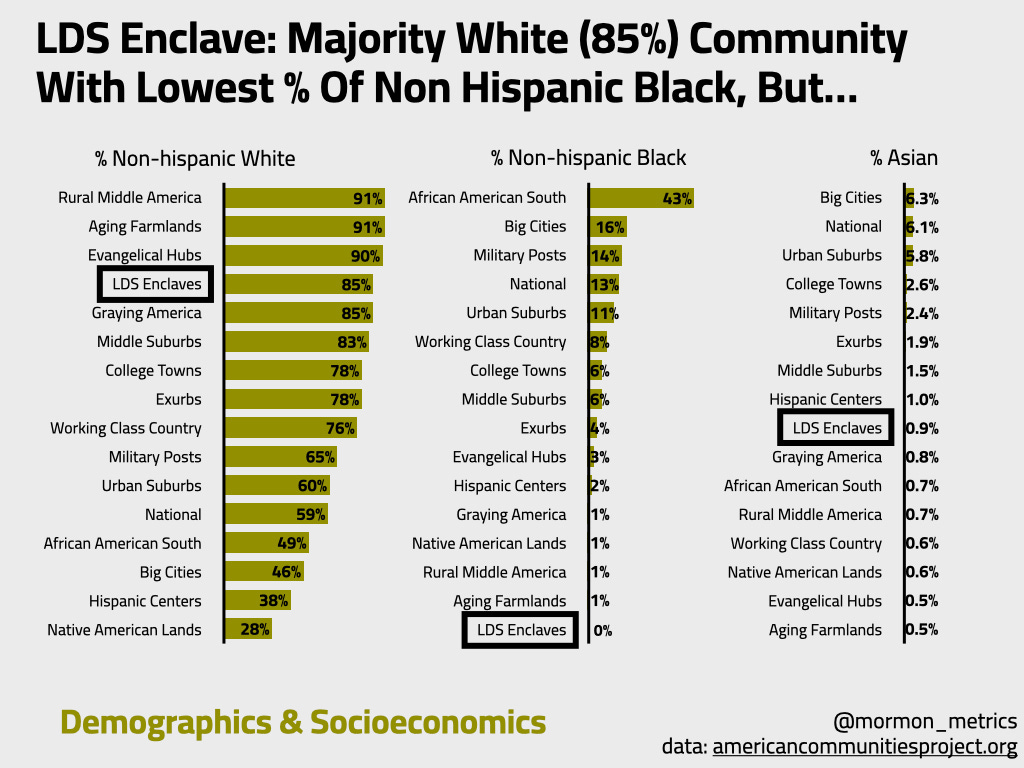
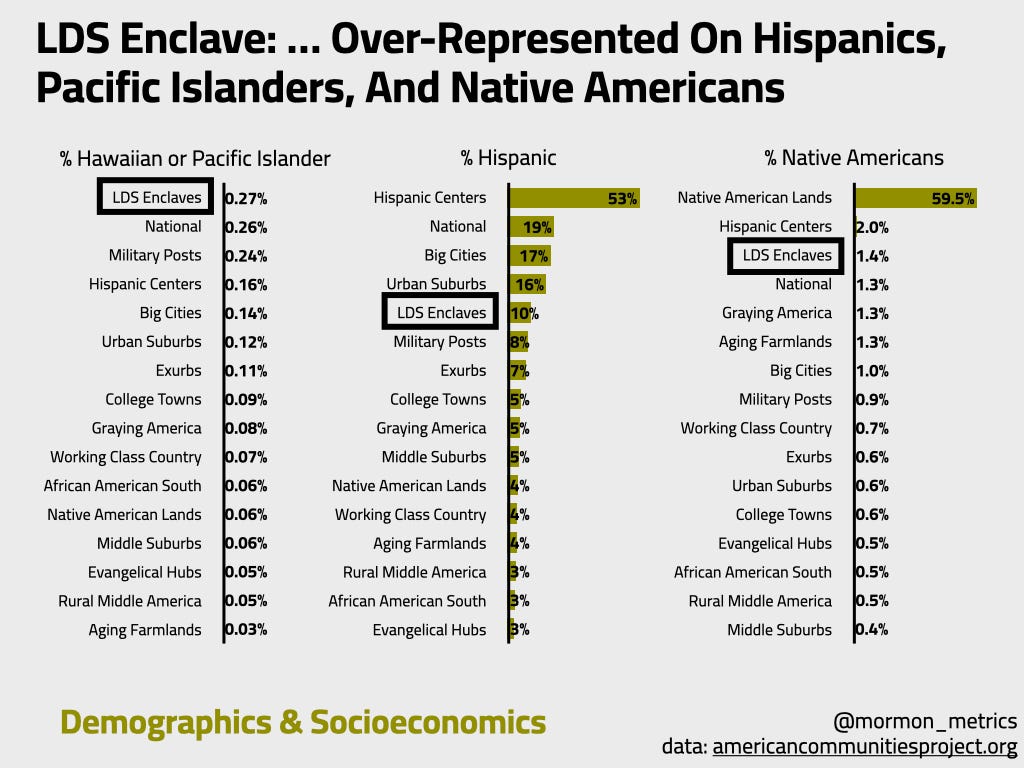
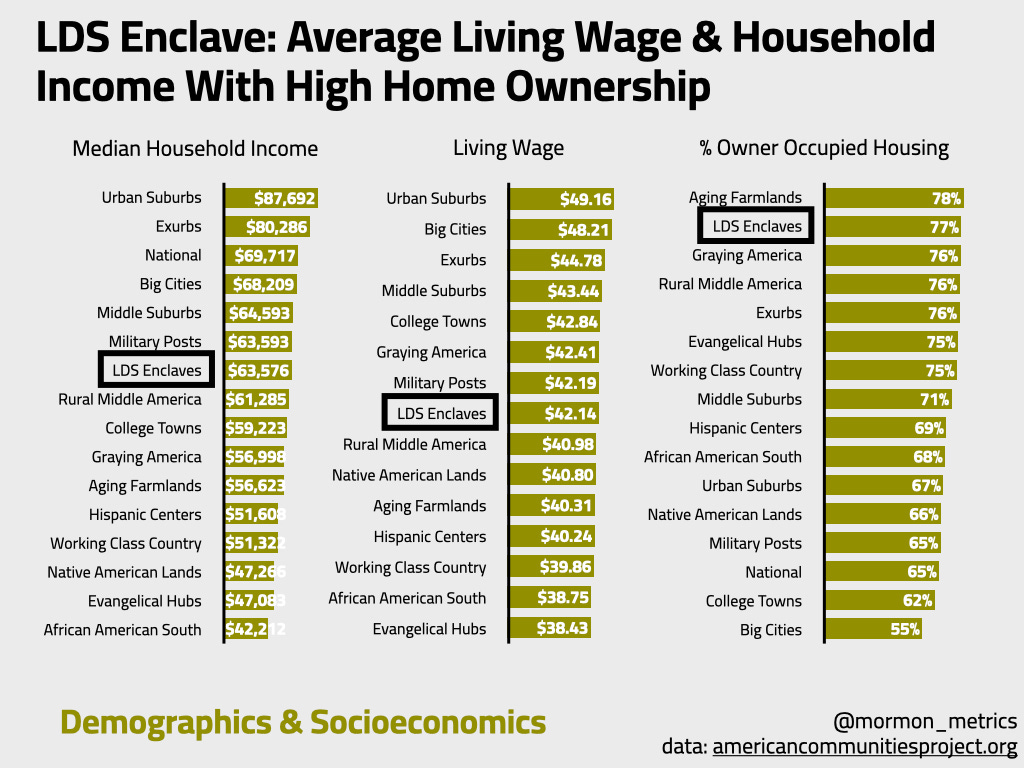
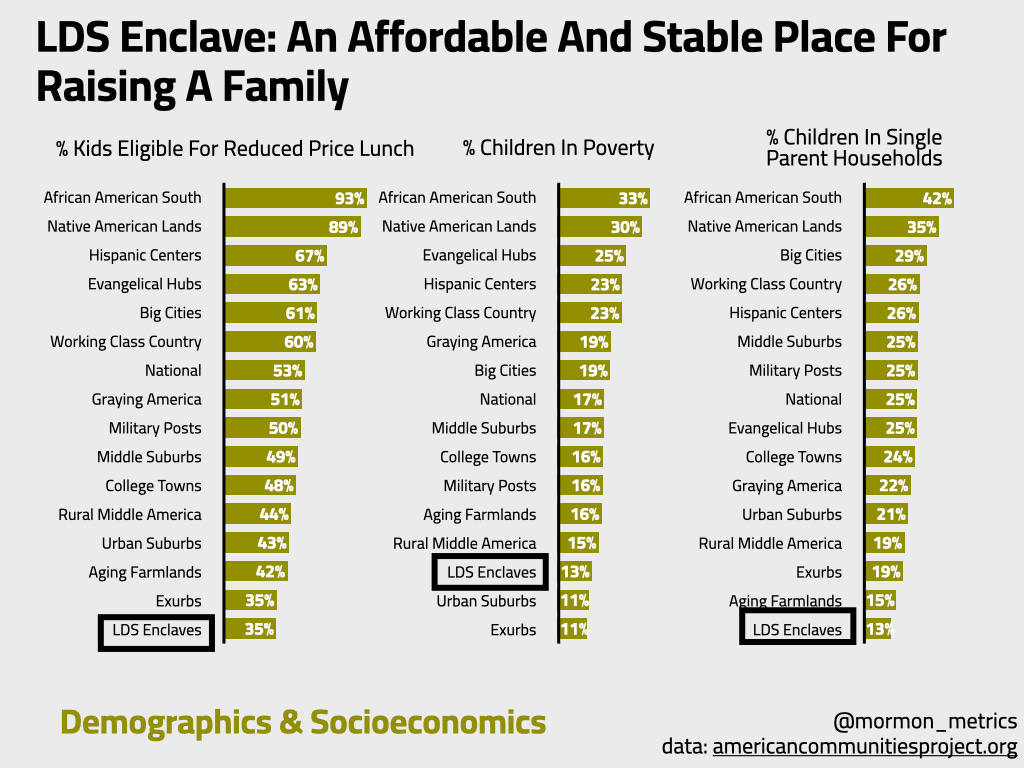
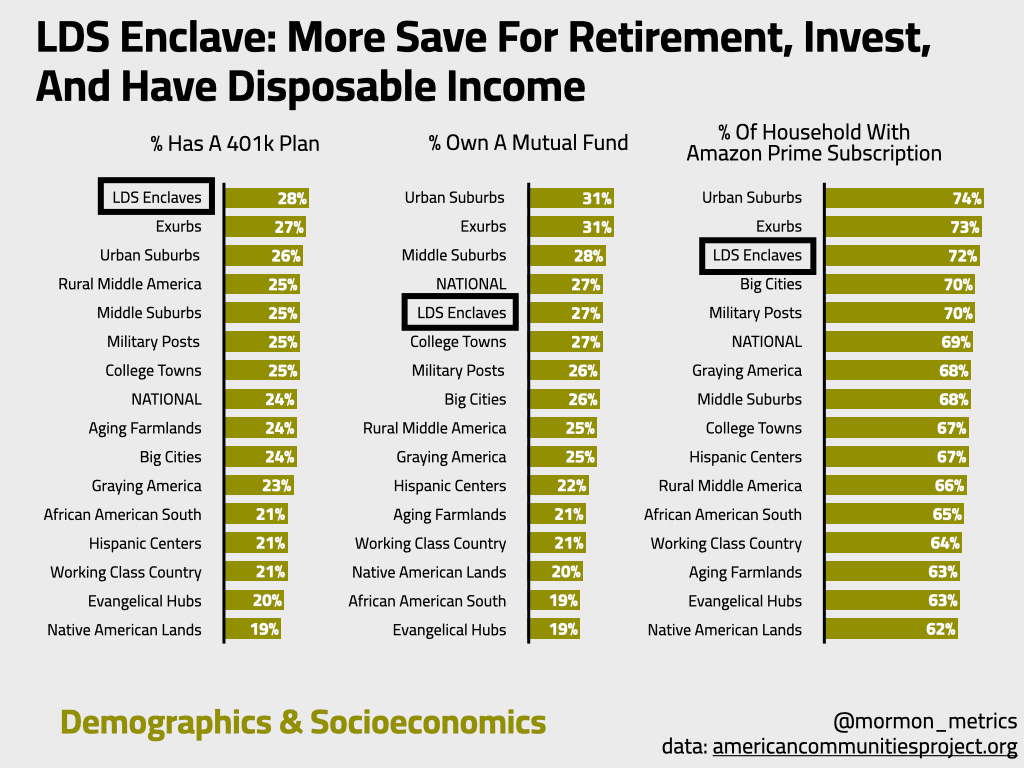
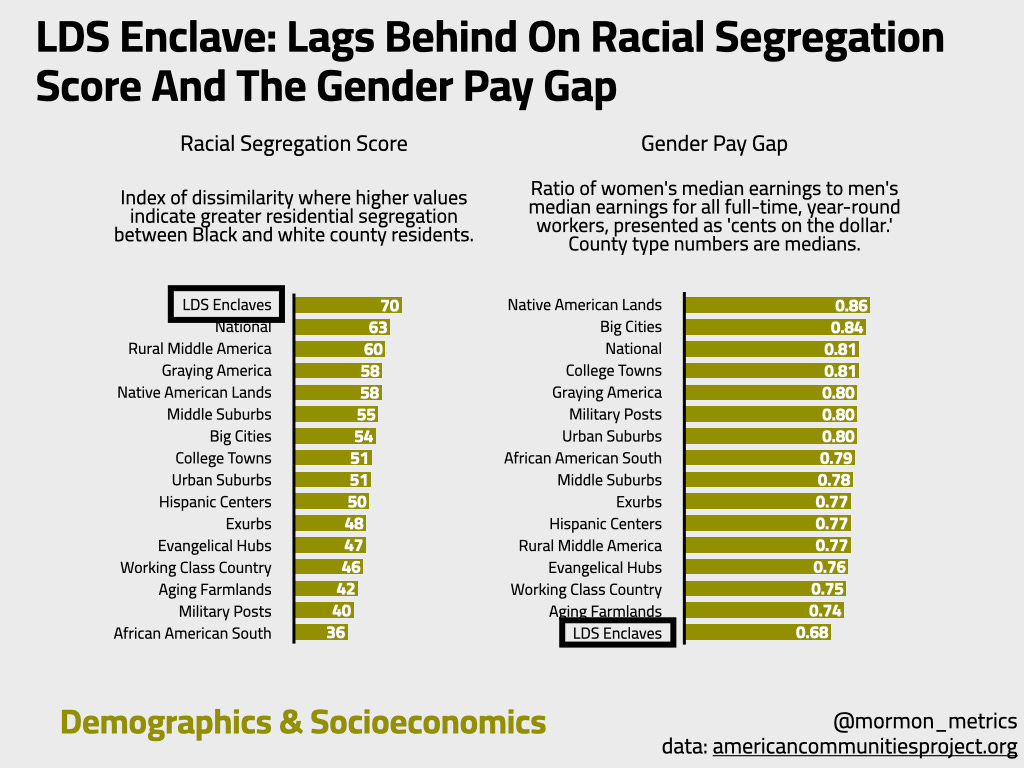

A lot of the Church's strengths go back directly to Joseph Smith's original teachings--the emphasis on education (which he shared with and inherited from Protestant, and especially Calvinist, Christianity); the preference for city life, (embodied in the plat for the City of Zion, with farmers living in town and working outside); the communal economic sensibility embodied in the United Order, whose remnant lingers in our welfare system; and the close-knit social order and organized sharing of civic responsibilities that reigns in our wards and stakes, and which includes our insistent blurring of the boundaries between sacred and secular, between spiritual and temporal.
Great analysis. I would encourage to elaborate a bit more on gender pay differences. Many researchers have found that personal choices explain the differences, not gender. The debate revolves around whether the gap is primarily due to different job choices, career interruptions for family care, or other factors. Please see: https://www.cato.org/commentary/gender-pay-gap-myth-wont-go-away